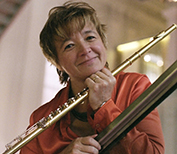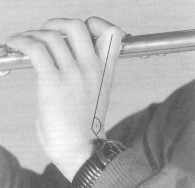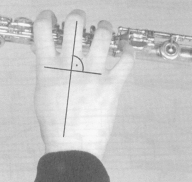The tongue
The problem with the tongue and its movements is that we don’t see them and therefore need to learn to feel them.
Question 1)
Where does my tongue touch my palate and/or upper incisors when I pronounce a "d"?
Information 1)
"d" is important"”it must never be "th"! As a neutral starting point, I suggest a position where the slightly tensioned tip of your tongue touches both the teeth and gum and then jumps off and falls behind the lower incisors. That is where the tongue and the back side of the lower incisors need to shape the duct used to blow air into the flute.
Question 2)
What kind of "g", "gk", "kg", "kh" should I use for rear articulation?
Information 2)
A strong "g" pronounced as close to the teeth as possible should be your starting point. The movement to perform is rather small and should be invisible on the neck. Careful: try to pronounce the "d" and "g" the French way, i.e. without aspiration and tied directly to the note you play.
The tongue only opens the path for the air"”it should not thrust the air. The term "tonguing" is therefore somewhat misleading.
Exercise 1)
Say "deux_deux_deux_deux_" (French for "2"); the underscore means that you need to sustain the "eux" part in a slow quarter-note pulse.
Now try "go_go_go_go_" (British upper-class pronunciation)
The movements should be small and only occur at the front or at the back. The tongue’s center must not move. You could also pretend to be sipping hot tea"”your tongue automatically assumes the perfect "flute position". Now speed up the tempo:
Deuxdeuxdeuxdeux gogogogo deuxdeuxdeuxdeux gogogogo...
Keep it as constant as possible. You can speed up this exercise without blowing into your flute. It might be a good idea to use the metronome.
Exercise 2)
Slit your lips and quickly blow cold air into the palms of your hands. Then, try adding some articulation, alternating between "d" and "g". The air speed should return instantly to its original tempo, there should be no noticeable interruption caused by the tongue.
Exercise 3)
Choose your favorite note on the flute and sustain it until you are really happy with the sound.
Sustain the note again and insert some "d" and "g" noises here and there (no particular rhythm). The aspect to pay attention to is to keep the tone quality constant!
If you hear noises or changes to the sound, check your tongue’s position in the mouth, the articulation position and the path of your movements.
Subsequent exercises: first your favorite note, then all other notes.
Exercise 4)
In a slow tempo"”e.g. eighth notes at 52BPM"”play
Deuxdeuxdeuxdeux gogogogo deuxdeuxdeuxdeux gogogogo...
From this point on, follow 2 paths:
A) Keep increasing the tempo for exercise 4) and alternate with exercise 3) to improve your sound. Practice with your metronome, and gradually increase the tempo. If you notice irregularities or tongue fatigue, take a short break and decrease the tempo.
B) Change the syllable sequence:
Deuxdeux gogo, deuxdeux gogo, deuxdeux gogo...
Go deux go deux go deux go deux...
Deux go deux go deux go deux go
Next, increase the tempo of exercise B). Of all the exercises mentioned above, only the last one requires double-tonguing"”and it is the least important, because it quite naturally results from the preceding exercises!
And now the fingers!
Obviously, the tongue and your fingers need to work together to avoid mix-ups! Your fingers should be trained with legato notes, because they allow you to spot possible irregularities. Luckily, we can watch our fingers, albeit only by playing in front of a mirror. So go to a mirror and watch your fingers"”they should always hover over the keys. Use your wrists to "lead" your fingers to the flute, ready to press a key when necessary. The position and shape of your hands and fingers is key to your success.
Start out with 2 tones and play them to a metronome beat: first as eighth notes, then as triplets and finally as sixteenth notes. The movement should remain perfectly constant. You could use the "fit for the flute" fingering (UE no. 31 291)
next, work with 3, then 4 and then 5 notes and continue with Taffanel & Gaubert’s "Daily Exercise".
And from this point on, follow 2 paths:
A) Expand your sonic range with extensive practice in the 3rd octave and other difficult note changes, like C/D, C#/D and E/F#.
B) Gradually increase the metronome tempo. Obviously you should only speed up exercises you have mastered, and keep working patiently on the others.
Try to keep your movements minimal, because the less you move, the faster you can play!
Combining the fingers and tongue
So far, so good. The only thing that is missing is a way of combining these two techniques. Grab one of your technique books, like M.A. Reichert’s daily exercises (no. 1) and practice legato notes until you are happy with the sound. Next, play each note of exercise 8 alternately with double-tonguing, then 6 times, 4 times, and twice.
After that, consider lowering the tempo a little and play each note once, i.e. the entire exercise with double-tonguing. And again compare the tone quality with your legato version. I suspect there will still be a few notes that need improving. So go back to the exercises above and get to work.
The approach shown here can also be applied to the pieces you are preparing for a performance!
I hope you like what you have achieved. And don’t despair! Spending 10 minutes a day working on these aspects will help you improve in leaps and bounds"”and that will make you proud.
Good luck!
Prof. Barbara Gisler Haase
Teaches flute at the University of Music and Preforming Arts in Vienna, where she also heads the Wind and Percussion Institute. Author of the flute methods "magic flute" and "fit for the flute", co-inventor of the "Waveline", or "Loop" flute, which is enjoying great international interest. Performances and juries in various countries, several CDs.





